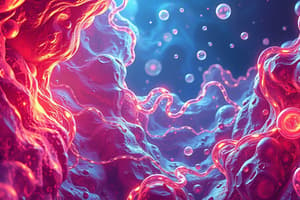Podcast
Questions and Answers
What type of lipid is primarily stored in solid form at room temperature and is produced only by animals?
What type of lipid is primarily stored in solid form at room temperature and is produced only by animals?
- Waxes
- Steroids
- Fats (correct)
- Oils
Which of the following structures describes the three-dimensional form of proteins?
Which of the following structures describes the three-dimensional form of proteins?
- Primary structure
- Tertiary structure (correct)
- Quaternary structure
- Secondary structure
What is the chief characteristic of unsaturated fatty acids?
What is the chief characteristic of unsaturated fatty acids?
- They contain no carbon-carbon double bonds.
- They are produced only by animals.
- They are solid at room temperature.
- They have multiple double bonds. (correct)
Which component is NOT part of a nucleotide in nucleic acids?
Which component is NOT part of a nucleotide in nucleic acids?
What is the defining characteristic of a random copolymer?
What is the defining characteristic of a random copolymer?
Which of the following best defines the quaternary structure of proteins?
Which of the following best defines the quaternary structure of proteins?
Which property of polymers measures their ability to expand or contract when heated?
Which property of polymers measures their ability to expand or contract when heated?
What type of lipid forms a waterproof barrier and is produced from the combination of a long-chain alcohol and a fatty acid?
What type of lipid forms a waterproof barrier and is produced from the combination of a long-chain alcohol and a fatty acid?
What is true about the crystalline structure of polymers?
What is true about the crystalline structure of polymers?
What was significant about Friedrich Wöhler's 1828 experiment?
What was significant about Friedrich Wöhler's 1828 experiment?
Which type of biomolecule is primarily responsible for storing and transmitting genetic information?
Which type of biomolecule is primarily responsible for storing and transmitting genetic information?
What is the primary function of lipids in cellular structures?
What is the primary function of lipids in cellular structures?
Which level of protein structure involves the folding of the polypeptide chain into a three-dimensional shape?
Which level of protein structure involves the folding of the polypeptide chain into a three-dimensional shape?
What type of lipid is primarily used for long-term energy storage in the body?
What type of lipid is primarily used for long-term energy storage in the body?
Which of the following statements about polymers is incorrect?
Which of the following statements about polymers is incorrect?
What is the smallest functional unit of a polymer known as?
What is the smallest functional unit of a polymer known as?
Which method is commonly used to convert aniline to acetanilide?
Which method is commonly used to convert aniline to acetanilide?
What is the primary use of acetylene in organic chemistry?
What is the primary use of acetylene in organic chemistry?
What functional groups are present in p-nitroacetanilide?
What functional groups are present in p-nitroacetanilide?
What type of reaction forms dibenzalacetone from aldehydes and ketones?
What type of reaction forms dibenzalacetone from aldehydes and ketones?
Which is true regarding the solubility of dibenzalacetone?
Which is true regarding the solubility of dibenzalacetone?
What intermediate is formed during the coupling reaction to prepare 2-naphthol aniline dye?
What intermediate is formed during the coupling reaction to prepare 2-naphthol aniline dye?
What is the main industrial application of p-nitroacetanilide?
What is the main industrial application of p-nitroacetanilide?
What is the outcome of an aniline reacting with 2-naphthol in the presence of benzene diazonium chloride?
What is the outcome of an aniline reacting with 2-naphthol in the presence of benzene diazonium chloride?
Flashcards
Organic Chemistry
Organic Chemistry
The branch of chemistry studying organic compounds' structure, properties, reactions, and preparation.
Acetylation
Acetylation
Replacing a hydrogen in a molecule with an acetyl group (CH3CO-).
Aniline
Aniline
An amine compound used to make dyes, and somewhat soluble in water.
Acetylene
Acetylene
Signup and view all the flashcards
Claisen-Schmidt Reaction
Claisen-Schmidt Reaction
Signup and view all the flashcards
Dibenzalacetone or Dibenzylideneacetone
Dibenzalacetone or Dibenzylideneacetone
Signup and view all the flashcards
p-Nitroacetanilide
p-Nitroacetanilide
Signup and view all the flashcards
Coupling Reaction (for 2-naphthol aniline dye)
Coupling Reaction (for 2-naphthol aniline dye)
Signup and view all the flashcards
Secondary Structure of Proteins
Secondary Structure of Proteins
Signup and view all the flashcards
Tertiary Structure of Proteins
Tertiary Structure of Proteins
Signup and view all the flashcards
Quarternary Structure of Proteins
Quarternary Structure of Proteins
Signup and view all the flashcards
Lipids
Lipids
Signup and view all the flashcards
Fatty Acids
Fatty Acids
Signup and view all the flashcards
Saturated Fatty Acid
Saturated Fatty Acid
Signup and view all the flashcards
Unsaturated Fatty Acid
Unsaturated Fatty Acid
Signup and view all the flashcards
Steroids
Steroids
Signup and view all the flashcards
Waxes
Waxes
Signup and view all the flashcards
Nucleic Acids
Nucleic Acids
Signup and view all the flashcards
Friedrich Wöhler's Experiment
Friedrich Wöhler's Experiment
Signup and view all the flashcards
Thermosets
Thermosets
Signup and view all the flashcards
Copolymer
Copolymer
Signup and view all the flashcards
Random Copolymer
Random Copolymer
Signup and view all the flashcards
Alternating Copolymer
Alternating Copolymer
Signup and view all the flashcards
Block Copolymer
Block Copolymer
Signup and view all the flashcards
Graft Copolymer
Graft Copolymer
Signup and view all the flashcards
Heat Capacity
Heat Capacity
Signup and view all the flashcards
Thermal Expansion
Thermal Expansion
Signup and view all the flashcards
Crystallinity
Crystallinity
Signup and view all the flashcards
Permeability
Permeability
Signup and view all the flashcards
Elastic Modulus
Elastic Modulus
Signup and view all the flashcards
Tensile Strength
Tensile Strength
Signup and view all the flashcards
Resilience
Resilience
Signup and view all the flashcards
Refractive Index
Refractive Index
Signup and view all the flashcards
Unreactivity
Unreactivity
Signup and view all the flashcards
Resistance to Electric Current
Resistance to Electric Current
Signup and view all the flashcards
Biomolecules
Biomolecules
Signup and view all the flashcards
Carbohydrates
Carbohydrates
Signup and view all the flashcards
Study Notes
Polymers
- Polymers are materials made of repeating smaller units called monomers.
- Many biological molecules are polymers.
- Polymers are classified as thermosetting or thermosoftening.
- Thermosetting polymers are permanently hardened by heat.
- Thermosetting polymers cannot be resoftened once cured.
- Thermosoftening polymers can change shape when heated.
Polymer Structures
- Linear polymers have long, straight chains of atoms.
- Branched polymers have branches attached to their chains.
- Crosslinked polymers have chains that are linked together to form a 3D network.
- Networked polymers have heavily cross-linked chains creating a complex 3D network.
Types of Polymers
- Polyethylene (PE): A thermoplastic used in many consumer products.
- Polypropylene (PP): A thermoplastic widely used in packaging and household goods.
- Polyethylene terephthalate (PET): A thermoplastic widely used in beverage bottles and clothing.
- Polybutadiene (PBD): A synthetic rubber used in tires and cables
- Polyisobutylene (PIB): A synthetic rubber with excellent toughness and flexibility.
- Polypropylene glycidyl ether (PGE): A flexible adhesive polymer used for paints, adhesives, plastics.
- Polyethylene-co-vinyl acetate (PE-VA): A thermoplastic with excellent flexibility and impact resistance, used in packaging.
Polymer Properties
- Heat Capacity: The ability of a polymer to insulate against heat flow.
- Thermal Expansion: How much a polymer expands or contracts when heated.
- Crystallinity: The degree to which polymer chains are arranged in a regular structure.
- Permeability: The tendency of a polymer to allow passage of other materials.
- Elastic Modulus: A measure of a polymer's resistance to deformation when stressed.
- Tensile Strength: The force required to break a polymer.
- Resilience: The ability of a polymer to resist abrasion and wear.
- Refractive Index: The extent to which the polymer affects light as it passes through it.
- Unreactivity: How resistant a polymer is to chemicals
Carbohydrates
- Carbohydrates are also known as saccharides.
- Carbohydrates are a major source of energy for the body.
- Their general formula is (CH₂O)n.
- Monosaccharides are the simplest sugars.
- Disaccharides are composed of two monosaccharides.
- Polysaccharides are composed of many monosaccharides, including starch, glycogen, and cellulose.
Proteins
- Proteins are polymers of amino acids.
- The fundamental elements of protein include H, C, O, and N.
- Proteins have four levels of structure: primary, secondary, tertiary, and quaternary.
- Primary Structure is the amino acid sequence.
- Secondary Structure are patterns of local folding.
- Tertiary structure is the three-dimensional arrangement of the entire polypeptide chain.
- Quarternary structure describes how different polypeptides associate with each other.
Lipids
- Lipids are a chief source of stored energy in cells.
- Lipids consists of nearly 3.5% of the whole cell contents.
- Lipids are insoluble in water but soluble in organic solvents.
- Lipids are composed primarily of C, H, and O.
- Common lipids include fatty acids, triglycerides, steroids, and waxes.
Nucleic Acids
- Nucleic acids are the genetic material of cells.
- Composed of repeating monomeric nucleic acids.
- Each nucleotide consists of a 5-carbon pentose sugar, a phosphate group, and a nitrogenous base.
Organic Chemistry
- Organic compounds are compounds that contain carbon.
- Many elements (particularly hydrogen, oxygen, and nitrogen) are linked by covalent bonds to carbon atoms.
Studying That Suits You
Use AI to generate personalized quizzes and flashcards to suit your learning preferences.




